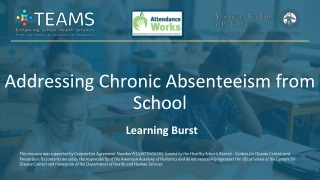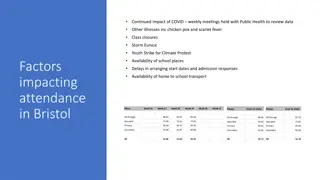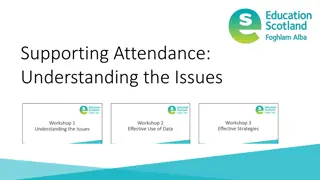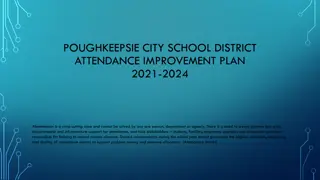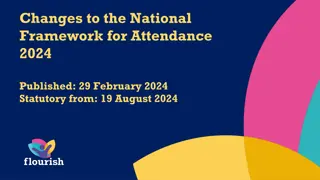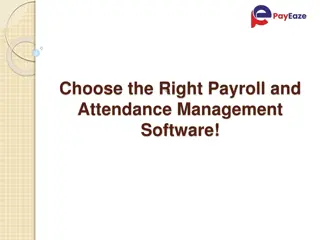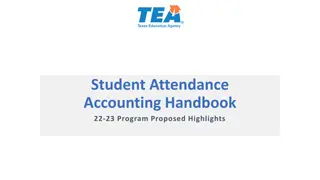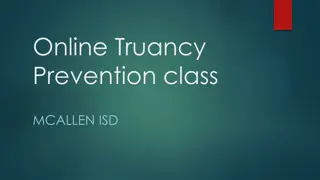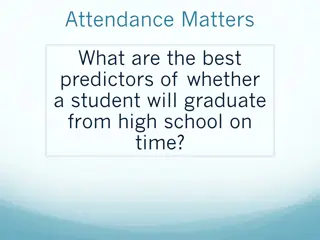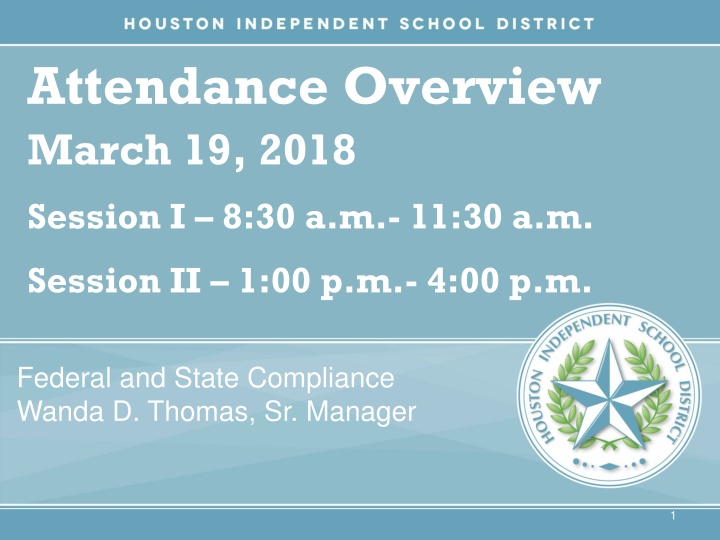
School Attendance Guidelines and Compliance Information
Explore the essential guidelines for school attendance compliance including Texas Education Agency rules, student attendance and funding requirements, responsibilities of school principals, and Houston ISD board policies. Learn about maintaining accurate attendance records for federal and state compliance.
Download Presentation

Please find below an Image/Link to download the presentation.
The content on the website is provided AS IS for your information and personal use only. It may not be sold, licensed, or shared on other websites without obtaining consent from the author. If you encounter any issues during the download, it is possible that the publisher has removed the file from their server.
You are allowed to download the files provided on this website for personal or commercial use, subject to the condition that they are used lawfully. All files are the property of their respective owners.
The content on the website is provided AS IS for your information and personal use only. It may not be sold, licensed, or shared on other websites without obtaining consent from the author.
E N D
Presentation Transcript
Attendance Overview March 19, 2018 Session I 8:30 a.m.- 11:30 a.m. Session II 1:00 p.m.- 4:00 p.m. Federal and State Compliance Wanda D. Thomas, Sr. Manager 1
Texas Education Agency Rules Each school must have a copy of the current Student Attendance Accounting Handbook published by the Texas Education Agency. The rules in the State handbook govern the procedures used by all districts. No school officer or any other person in the school district has the authority to change these instructions. At the end of the year, all records must be signed by a certified person and delivered to the superintendent, who is responsible for the safekeeping of all attendance records and reports. Each year, instructions will be sent to schools regarding packaging and delivery of attendance documents. The following personnel must be aware of their responsibilities in following the state rules for attendance accounting: administrators, teachers, special program coordinators, and attendance personnel. https://tea.texas.gov/Finance_and_Grants/Financial_Compliance/Student__Attendance_Accounting_Handbook/ 2
1.1 Student Attendance and FSP Funding The primary purpose for the TEA s collection of student attendance data is to ensure that Foundation School Program (FSP) funds can be allocated to Texas s public schools. All public schools in Texas must maintain records to reflect the average daily attendance (ADA) for the allocation of these and other funds by the TEA. 19 Texas Administrative Code (TAC) 129.21(a) 3
Texas Education Agency Rules Regarding Responsibility The principal of each campus is responsible for reviewing his or her Campus Summary Reports for completeness and accuracy. Reports from the Texas Education Agency (TEA), which reflect Public Education Information Management System (PEIMS) data, should be compared to locally-produced reports for reasonableness and accuracy. The principals affirm that they have checked, or caused to be checked, the accuracy and authenticity of the attendance data by signing the Campus Summary Report. The principal is ultimately responsible for the accuracy and safekeeping of all attendance records and reports. These records must be available for audit. General Attendance Requirements 2018-2019 Student Attendance Accounting Handbook Page 33 4
Houston ISD Board Policy on Classroom Attendance The role of the principal (and administrative team) is to: establish a period by period attendance management system; design and implement a process for identifying and counseling students with attendance problems; communicate with parents about student attendance problems; approve credit for excused absences; chair the statutorily required School Attendance Committee 5
Texas Education Agency Rules Regarding Responsibility The teacher who initially records an absence is responsible for the accuracy of the report and attests to the validity of the data with his or her signature or, in the case of a paperless attendance accounting system, with his or her entry of those data using the teacher s logon with a district secret password. General Attendance Requirements 2018-2019 Student Attendance Accounting Handbook Page 33 6
Houston ISD Board Policy on Classroom Attendance The role of the teacher is to: take attendance at the official time designated and for each class period; maintain accurate attendance records in GradeSpeed and verify accuracy of Chancery records; send excuse notes from parents to the office in a timely manner; notify parents when a student returns from an absence without an excuse or has been absent for three or more days; insure that students make up work for excused and unexcused absences; complete an attendance referral form for appropriate students, in accordance with district guidelines 7
Texas Education Agency Rules Regarding Responsibility The attendance personnel generating absence summaries and/or transcribing the absences or coding information into the computer are responsible for adhering to all laws and regulations pertaining to student attendance accounting. Each person entering data into the attendance accounting system must sign an affidavit attesting that the data he or she has entered is true and correct to the best of his or her knowledge. In no case should attendance personnel be assigned the responsibility of determining a student s coding information General Attendance Requirements 2018-2019 Student Attendance Accounting Handbook Page 34 8
Texas Education Agency Rules Important: In no case should attendance personnel be assigned the responsibility of determining a student's coding information. Special program staff, directors, and/or teachers should provide attendance personnel with names and coding information of students who are eligible, whose documentation is in order, and who are being served in accordance with an individualized education program (IEP). Special program directors and/or staff are responsible for reviewing special program data and totals for accuracy and completeness. They are also responsible for ensuring that attendance personnel are aware of any changes in a student's services and the effective dates of such changes. The attendance personnel are then responsible for entering the changes in the detailed student attendance accounting system (manual or automated). At the end of each six-week reporting period, special program staff should verify the Student Detail Report for any coding errors. General Attendance Requirements 2018-2019 Student Attendance Accounting Handbook Page 34 9
Texas Education Agency Rules Taking and Recording Student Attendance District personnel must create the original documentation of attendance at the time of attendance. Original documentation may not be created after the fact. Original documentation that is not created at the time of attendance will not be accepted by agency auditors. If auditors determine that original documentation was not created at the time of the attendance it is intended to support, the TEA will retain 100% of your district's FSP allotment for the inappropriately documented attendance for the school year(s) for which records have been requested. The TEA will either assess an adjustment to subsequent allocations of state funds or require your district to refund the total amount of the adjustment when the audit is finalized. General Attendance Requirements 2018-2019 Student Attendance Accounting Handbook Page 34 10
3.2 Membership and Eligibility for Attendance and Foundation School Program (FSP) Funding Both membership and eligibility to generateaverage daily attendance (ADA) are related to the amount of time that a student receives instruction each day. However, they are not the same. A student is in membership in your district if the student is enrolled in the district and is either: scheduled to attend at least 2 hours of instruction each school day or participating in an alternative attendance accounting program. A student who meets the criteria above is in membership regardless of whether the student is eligible to generate ADA. A student is eligible to generate ADA, and thus FSP funding, only if the student is in membership and also meets the ADA eligibility requirements described in the following subsections. General Attendance Requirements 2018-2019 Student Attendance Accounting Handbook Page 34 11
3.2.1 ADA Eligibility Coding A student s eligibility to generate ADA is reported with what is called an ADA eligibility code. Your district must use the following codes when reporting student attendance. Note: The 2-through-4-hour rule includes recess and in-class breakfast. General Attendance Requirements 2018-2019 Student Attendance Accounting Handbook Page 34 12
3.2.1.1 Code 0 Enrolled, Not in Membership Code 0 indicates that a student is enrolled but is not in membership. Code 0 applies to students who are scheduled for and provided fewer than 2 hours of instruction by your district each school day and are not participating in an alternative attendance accounting program. This code is used for the following: a child who is scheduled to attend for fewer than 2 hours of instruction each school day, including a high school student who has met all graduation requirements other than passing required state assessments and who continues to attend school to participate in a study program for those tests if the student is scheduled for and attendingfewer than 2 hours of study program instruction each day (see Error! Reference source not found.) a child who attends a nonpublic school but receives some services from your district (for example, speech therapy services only) a student who is provided instruction totally in a federal Head Start program a student who has graduated but returned to school (for fewer than 2 hours of instruction per day) to further his or her education a student who receives all his or her special education and related services through an approved nonpublic school a parentally placed private school student with a disability, 5 through 21 years of age, who receives special education and related services through a services plan (see 4.5 Special Education Services for Private or Home School Students Who Are Eligible for and in Need of Special Education) A student coded with an ADA eligibility code of 0 is not eligible to generate ADA or FSP funding. General Attendance Requirements 2018-2019 Student Attendance Accounting Handbook Page 35 13
3.2.1.2 Code 1 Eligible for Full-Day Attendance Code 1 indicates that a student is eligible to generate full-day attendance. Code 1 applies to all students entitled to enroll under the Texas Education Code (TEC), 25.001, who are scheduled for and provided instruction for at least 4 hours each school day. Note: Districts that offer half-day kindergarten programs must not count students who attend both the morning and afternoon half-day sessions for eligible full-day attendance. General Attendance Requirements 2018-2019 Student Attendance Accounting Handbook Page 35 14
3.2.1.3 Code 2 Eligible for Half-Day Attendance Code 2 indicates that a student is eligible to generate half-day attendance. Code 2 applies to all students entitled to enroll under the TEC, 25.001, who are scheduled for and provided instruction for at least 2 hours but fewer than 4 hours each school day. These students include prekindergarten (PK) students who meet the eligibility requirements in Section 7 (see 7.5 Eligible Days Present and ADA Eligibility). General Attendance Requirements 2018-2019 Student Attendance Accounting Handbook Page 35 15
3.2.1.4 Code 3 Eligible Transfer Student Full-Day Code 3 indicates that a student is a transfer student who is eligible to generate full-day attendance. Code 3 applies to a student who is a nonresident, is legally transferred into your district, and is scheduled for and provided instruction for at least 4 hours each school day. This code applies only to a student who transfers from one Texas school district to another; such a student must meet all eligibility criteria other than residency. General Attendance Requirements 2018-2019 Student Attendance Accounting Handbook Page 35 16
3.2.1.5 Code 4 Ineligible Full-Day Code 4 indicates that a student is provided instruction for at least 4 hours each school day but is ineligible to generate ADA. The students that code 4 applies to include any student who is scheduled for and provided full-day instruction but does not meet the eligibility criteria for the service he or she receives. The types of students who are coded ineligible are listed below. General Attendance Requirements 2018-2019 Student Attendance Accounting Handbook Page 36 17
3.2.1.5.1 Underage: children provided instruction in a preschool program for children with disabilities (PPCD) who are under the age of 3, except for children with serious visual or hearing impairments or both children provided instruction in PK who are under the age of 3 on September 1 of the current school year children provided instruction in any grade (K 12) who are under age 5 on September 1 of the current school year are ineligible for full-day funding (see the notes under the table in 3.2.3 Age Eligibility for exceptions). However, a 4-year-old who is eligible for PK is eligible for half-day funding even if the student is provided instruction in a kindergarten classroom. The student must be coded with a grade level of PK. General Attendance Requirements 2018-2019 Student Attendance Accounting Handbook Page 36 18
3.2.1.5.2 Overage: students who are 26 years old on September 1 of the current school year General Attendance Requirements 2018-2019 Student Attendance Accounting Handbook Page 36 19
3.2.1.5.3 Other: nonresident students who have not been transferred into your district students who reside outside the boundaries of the state of Texas students served by a juvenile justice alternative education program (JJAEP) on the basis of an expulsion under the TEC, 37.007(a), (d), or (e), unless specifically authorized in writing by the TEA students placed in residential facilities within your district whose maintenance expenses are paid in whole or in part by another state or the United States students who are required, as a condition of obtaining or holding the appropriate United States (US) student visa, to pay tuition to your district to cover the cost of their education General Attendance Requirements 2018-2019 Student Attendance Accounting Handbook Page 36 20
3.2.1.6 Code 5 Ineligible Half-Day Code 5 indicates that a student is scheduled for and provided instruction for at least 2 hours but fewer than 4 hours each school day but is ineligible to generate ADA (for any of the reasons listed in the preceding subsection on code 4). The students that code 5 applies to include any student who is provided half-day instruction but does not meet the eligibility criteria for the service he or she receives. Examples include the following: students enrolled only in PK who do not meet the PK eligibility requirements in Section 7 students enrolled in locally funded PK programs offered by your district students provided instruction by a JJAEP on the basis of an expulsion under the TEC, 37.007(a), (d), or (e), unless specifically authorized in writing by the TEA students who are required, as a condition of obtaining or holding the appropriate US student visa, to pay tuition to your district to cover the cost of their education TEC, 25.0031(c) General Attendance Requirements 2018-2019 Student Attendance Accounting Handbook Page 37 21
3.2.1.7 Code 6 Eligible Transfer Student Half-Day Code 6 indicates that a student is a transfer student who is eligible to generate half-day attendance. Code 6 applies to a student who is a nonresident, is legally transferred into your district, and is scheduled for and provided instruction for at least 2 hours but fewer than 4 hours each school day. The student must meet all eligibility criteria other than residency. General Attendance Requirements 2018-2019 Student Attendance Accounting Handbook Page 37 22
3.2.1.8 Code 7 Eligible Alternative Attendance Program Participation Code 7 applies to a student who is eligible to participate in and is enrolled and provided instruction in an alternative attendance program, such as the Optional Flexible School Day Program (OFSDP) or the High School Equivalency Program (HSEP). General Attendance Requirements 2018-2019 Student Attendance Accounting Handbook Page 37 23
3.2.1.9 Code 8 Ineligible Alternative Attendance Program Participation Code 8 applies to a student who is enrolled and provided instruction in an alternative attendance program, such as the OFSDP or HSEP, but is ineligible to participate in the program. General Attendance Requirements 2018-2019 Student Attendance Accounting Handbook Page 37 24
3.2.2 Funding Eligibility To be eligible to generate FSP funding for attendance, a student must either: 1) be scheduled for and provided instruction at least 2 hours (half- day attendance) or at least 4 hours (full-day attendance) each day (referred to as the 2-through-4-hour rule ) or 2) be eligible for, enrolled in, and scheduled for and provided instruction in an alternative attendance accounting program (such as the OFSDP). 3) participate in work-based learning* opportunities for at least two hours (half-day attendance) or at least four hours (full-day attendance). Work-based learning opportunities include internships, externships, apprenticeships, mentorships, etc. (This is not an exhaustive list of work-based learning opportunities). 19 TAC 129.21(g) General Attendance Requirements 2018-2019 Student Attendance Accounting Handbook Page 37 25
3.3 Enrollment Procedures and Requirements A student must be enrolled in only one district at a time, thus eliminating duplicate TSDS PEIMS reporting for a student. Enrolling a student in a school district requires presentation of proof of the student s identity, age, and residency or other eligibility for enrollment. However, your school district may implement and use an automated system to confirm the address of a student who is continuing enrollment in your district from the prior school year. Your district may accept documentation of an updated address electronically for a student who is continuing enrollment in your district from the prior school year. To be eligible for FSP funding, your school district must maintain all proper documentation. Note: All documentation requirements for audit purposes and the required retention period for such records are outlined in Section 2. The required retention period for all school district records is outlined in Local Schedule SD of the Local Records Retention Schedules, Texas State Library and Archives Com mission. See Houston ISD Records Management website: http://www.houstonisd.org/site/handlers/filedownload.ashx?moduleinstanceid=228291&dataid=191339&FileName=HISD Schedule SD - Effective 2016-02-10.pdf General Attendance Requirements 2018-2019 Student Attendance Accounting Handbook Page 43 26
3.3.4 Failure to Receive Student Records and Discrepancies in Student Names Failure to receive the information required for student enrollment must not preclude your district from enrolling and serving a student.42 However, only students who meet the age and admission requirements may be reported as eligible for FSP purposes (ADA eligibility codes 1, 2, 3, 6, or 7) (see also 3.3.8 Immunization). Your district may report an enrolled student it believes to be eligible for FSP purposes as eligible while awaiting documentation of eligibility from the student s previous school district or from the person enrolling the student. If a child is enrolled under a name other than the name that appears in the identifying documents, your district must notify the Missing Children and Missing Persons Information Clearinghouse at (800) 346-3243. If the student s records have not been received within 30 days of a request, making this comparison impossible, your district must notify the municipal police department or sheriff s department of the county for a determination of whether the child has been reported as missing.43 General Attendance Requirements 2018-2019 Student Attendance Accounting Handbook Page 45 27
3.3.5 Entry and Reentry Dates The student s entry date is the first day the student is physically present during the official attendance accounting period on a particular campus. A student s reentry date is the first day the student is physically present during the official attendance accounting period after having been withdrawn from the same campus. A student cannot be absent on either the entry or the reentry date. Also, a student cannot be absent on the first day of school. The student is in membership on both the entry date and the reentry date. See 3.2 Membership and Eligibility for Attendance and Foundation School Program (FSP) Funding for minimum time requirements for a student to be in membership. General Attendance Requirements 2018-2019 Student Attendance Accounting Handbook Page 45 28
3.3.7 Homeless Students A student who is homeless, as defined by the McKinney-Vento Homeless Assistance Act50, is entitled to enroll in any school district or open enrollment charter school in the state without regard to the student s residence.51 The student must be allowed to attend either the student s school of origin 52 ( school that the student attended when permanently housed or the school in which the student was last ) or the school serving the attendance area where the student is now located.53 Eligibility to enroll in any other school in any school district or open enrollment charter school is determined by local policy.54 A student is entitled to attend the school of origin if the student becomes homeless during a school year or between school years. Also, if the student becomes permanently housed during a school year, the student is entitled to attend the school of origin for the remainder of that school year. You can find more information on school district responsibilities associated with homeless students on the TEA Homeless Issues FAQ page and on website at http://www.utdanacenter.org/theo/. General Attendance Requirements 2018-2019 Student Attendance Accounting Handbook Page 47 29
3.3.8 Immunization Except as provided by the TEC, 38.001(c), a student is required to be fully immunized against certain diseases.55 However, your district may admit a student provisionally if the student has begun the required immunizations and continues to receive the necessary immunizations as rapidly as medically feasible.56 Except as provided by the TEC, 38.001(c), a student who is not fully immunized and has not begun the required immunization must not attend school. A homeless student may be admitted for 30 days pending initiation of vaccinations or receipt of vaccination documentation.57 A student who is a military dependent or any student coming from another Texas school may be enrolled for 30 days pending transfer of immunization records.58 General Attendance Requirements 2018-2019 Student Attendance Accounting Handbook Page 48 30
3.4 Withdrawal Procedures Your district should withdraw a student from the attendance accounting system on the date your district becomes aware the student is no longer a member of the district. With proof of enrollment in a different district or campus, retroactive withdrawals are permitted to the day a student enrolled in another school. Your district must update all attendance accounting records affected by such a change. (See also 3.3.5 Entry and Reentry Dates.) If a student withdraws before attendance is taken, the withdrawal date is that day. If a student withdraws after attendance is taken, the withdrawal date is the next school day. A student is not in membership on the withdrawal date. General Attendance Requirements 2018-2019 Student Attendance Accounting Handbook Page 49 31
3.4 Withdrawal Procedures 3.4.1 Students 19 Years of Age or Older Your district may withdraw a student who is at least 19 years old and is voluntarily enrolled in school when he or she accumulates more than five unexcused absences in a semester. Your district may revoke the enrollment of such a student for the remainder of the school year, except that a district may not revoke enrollment on a day on which the student is physically present at school.59 A student who is removed from school under this provision will be considered a dropout for accountability purposes unless the student returns to school during the school-start window the following fall. See the Secondary School Completion and Dropouts in Texas Public Schools annual publication for the current definition of dropout. (See also 3.5 Compulsory Attendance.) This authority to revoke enrollment does not override your district s responsibility to provide a free appropriate public education to a student who is eligible for special education services. General Attendance Requirements 2018-2019 Student Attendance Accounting Handbook Page 50 32
3.4 Withdrawal Procedures 3.4.2 Temporary Absences and Withdrawal Your district may not withdraw a student who is temporarily absent (e.g., as a result of illness or suspension) but still a member of your district. 3.4.3 Students Whose Whereabouts Are Unknown Your district should decide the withdrawal date for a student who never officially withdrew from school, but whose whereabouts can no longer be determined, according to applicable local policies. For example, local policy may state that a student is withdrawn 10 days after he or she last attended if his or her whereabouts are unknown. Once withdrawn, a student in grades 7 through 12 must be reported as a school leaver on a 203 Record and will possibly be considered a dropout according to Section 2 of the PEIMS Data Standards. General Attendance Requirements 2018-2019 Student Attendance Accounting Handbook Page 50 33
3.5 Compulsory Attendance PK and kindergarten students are subject to compulsory school attendance while they are enrolled in school. On enrollment in PK or kindergarten, a child must attend school.65 However, if a child has not reached mandatory compulsory attendance age (6 years old as of September 1 of the current school year) the child s parent or guardian may withdraw the student from school, and the child will not be in violation of compulsory attendance. Unless specifically exempted by the TEC, 25.086, a child who is at least 6 years of age, or who is younger than 6 years of age and has previously been enrolled in first grade, and who has not yet reached his or her 19th birthday must attend school.66 A person who voluntarily enrolls in or attends school after turning 19 years of age is also required to attend school each day67. Note that an allegation of truant conduct applies only to an individual who is 12 years of age or older and younger than 19 years of age.68 The offense of parent contributing to nonattendance, however, applies to parents of students who are subject to compulsory attendance, regardless of the student s age.69 General Attendance Requirements 2018-2019 Student Attendance Accounting Handbook Page 52 34
3.6 General Attendance-Taking Rules Each teacher or other school employee who records student attendance must certify, in writing, that all such records are true and correct to the best of his or her knowledge and that the records have been prepared in accordance with laws and regulations pertaining to student attendance accounting by signing and dating the record of attendance within one calendar week of the attendance recorded. Electronic signatures are acceptable. Signature stamps and pencil are not acceptable. Students who are on campus and in their classrooms at the time attendance is taken must have their official attendance taken and completed by the classroom teacher. Attendance must not be taken by students or classroom aides and clerks that do not meet the requirements of a highly qualified paraprofessional74. Using a student sign-in sheet to record attendance is not an acceptable method of taking roll and will result in the attendance being disallowed. General Attendance Requirements 2018-2019 Student Attendance Accounting Handbook Page 52 and 53 35
3.6.1 Manual Entries or Corrections to Student Attendance Data District staff members must always use ink to make manual entries or corrections in the attendance records, on daily absence slips, on 6-week absence reports, and on daily summary sheets. Staff members must never record manual entries in pencil, use liquid correction fluid, or use a signature stamp. If errors are made on any official attendance document, the staff member making the correction must strike through the error, enter corrections nearby, and initial. General Attendance Requirements 2018-2019 Student Attendance Accounting Handbook Page 53 This includes Color Coded Cards used by Houston ISD 36
3.6.2 Time of Day for Attendance Taking Each campus must determine attendance for all grades by the absences recorded at the one particular point in time the campus has chosen for roll to be taken (a snapshot, for example, 9:45 a.m.) during the second or fifth instructional hour of the day or its equivalent. The selected time may vary from campus to campus within your district. However, once a time has been selected, a campus must not change it during the school year. Your campus may select an official attendance-taking time that is not during the second or fifth instructional hour of the day if your local school board has adopted a district policy allowing for recording absences in an alternative hour, or if the superintendent has established documented procedures allowing for recording absences in an alternative hour after having been delegated authority to do so by the board. The policy or procedures may: allow for each campus to choose an alternative attendance-taking time for the campus as a whole, allow for each campus to choose an alternative attendance-taking time for certain groups of students as described in Subsection 3.6.2.2, or allow for both of these circumstances.19 TAC 129.21(h) General Attendance Requirements 2018-2019 Student Attendance Accounting Handbook Page 53 and 54 37
Absences for HISD Instructional Attendance Elementary teachers must check attendance each day. The absences are either excused or unexcused and must be recorded accordingly in GradeSpeed. These absences apply to the number and type of absences accumulated under the HISD instructional attendance policy as identified later in this section. The only acceptable excuses for tardies and absences are: Personal illness; Illness or death in the family; Quarantine; Weather or road conditions making travel dangerous; Participation in school activities with permission of the principal; or Emergencies or any unusual circumstances recognized by the principal or person designated; Any cause acceptable to the teacher, principal, or superintendent of the school in which the person is enrolled. Secondary teachers must check attendance each class period each day. The absences are either excused or unexcused and must be recorded accordingly in GradeSpeed. These absences apply to the number and type of absences accumulated under the HISD instructional attendance policy as identified later in this section. Absences for extracurricular activities do not count as absences as they apply to the HISD attendance policy unless a student accumulates more than five for one semester. 38
Absences for HISD Instructional Attendance If a student accumulates more than five absences for extracurricular activities for one semester in one class or subject, each absence over five becomes an unexcused absence, and these unexcused absences apply to the HISD attendance policy. Schools must have clear procedures and full faculty participation to avoid conflicting attendance reports. 39
Absences for HISD Instructional Attendance The reason for an excused absence must be stated orally or in writing and signed by the parent/guardian of the student or a school official. The written, electronic or oral excuse must be received by the school within three days after the absence or tardy. School personnel should document phone calls, email messages, or oral statements of parents excusing student absences. These notes should be kept by the classroom teacher or the attendance clerk and secured for storage at the close of the school year for storage. Teachers and principals may accommodate special circumstances for late notes or absence verification. The district attendance specialist assigned to the school may investigate any excused case. A student found guilty of misrepresenting the validity of an excuse or permit is subject to disciplinary action. 40
Houston ISD Board Policy on Classroom Attendance Acceptable excuses for absences and tardiness are personal illness, sickness, or death in the family, quarantine, weather, or road conditions making travel dangerous, participation in school activities with permission of the principal, and emergencies or unusual circumstances recognized by the principal or person designated. Supervision of student attendance will be the responsibility of teachers and school administrators. 41
MANUAL ATTENDANCE PROCEDURES Accepting Manual Attendance Taken by the Teacher of Record or a Substitute All manual attendance must be signed and dated by the Teacher of Record or the Substitute in black or blue ink no pencils Attendance personnel need to check to make sure that this has been done when receiving the manual attendance document The next sentence is only for Rosters Not Generated from GradeSpeed If the teacher or substitute has placed any of the following by a student s name, there should be a ledger describing what each symbol means Check marks - X s Hyphens - Asterisks * Highlighted the name It is best to put an A for absent by the student s name 42
3.6.3 Requirements for a Student to Be Considered Present for FSP (Funding) Purposes A student not actually on campus at the time attendance is taken may be considered in attendance for FSP purposes if the student is enrolled in and attending off-campus dual credit program courses and is not scheduled to be on campus during any part of the school day. Students who are enrolled in and attending an off-campus dual credit program course and are scheduled to be on campus during any part of the school day should have their attendance recorded while they are on campus. See 3.6.2.2 Alternative Attendance-Taking Time for Certain Student Populations for instructions on how to record attendance for these students if they are not scheduled to be on campus during the official attendance- taking time. is participating in an off-campus work-based learning opportunity and is not scheduled to be on campus during any part of the school day. Students who are participating in an off-campus work-based learning opportunity and are scheduled to be on campus during any part of the school day should have their attendance recorded while they are on campus. See 3.6.2.2 Alternative Attendance-Taking Time for Certain Student Populations for instructions on how to record attendance for students not scheduled to be on campus during the official attendance-taking time. is enrolled full-time in TxVSN courses. See 12.2 Texas Virtual School Network (TxVSN) for information on recording daily attendance. is participating in an activity that is approved by your local school board and is under the direction of a professional staff member, an adjunct staff member, or a paraprofessional staff member of your school district. The adjunct staff member must have a minimum of a bachelor s degree and be eligible for participation in the Teacher Retirement System of Texas. Paraprofessionals must meet the requirements of a highly qualified paraprofessional.80 is participating, with local school board approval, in a short-term (for example, 5-day) class that is provided by the Texas School for the Blind and Visually Impaired (TSBVI) or the Texas School for the Deaf (TSD) at a location other than the student s campus.81 The student must not be considered in attendance for FSP purposes on any day the student is traveling between the student s district and the location of the class but is not attending class. (However, travel days may be excused for compulsory attendance purposes. See 3.6.4 Excused Absences for Compulsory Attendance Purposes.) Your school district is responsible for obtaining documentation of the student s class attendance from the TSBVI or TSD. is participating in a mentorship approved by district personnel to serve as one or more of the advanced measures needed to complete the Distinguished Achievement Program outlined in 19 TAC Chapter 74. General Attendance Requirements 2018-2019 Student Attendance Accounting Handbook Page 55, 56 and 57 44
RELIGIOUS HOLY DAYS misses school for the purpose of observing religious holy days, including traveling for that purpose. Travel days for which the student is considered in attendance are limited to not more than 1 day for travel to and 1 day for travel from the site where the student will observe the holy days. Your school district may elect to excuse additional travel days; however, the student would be considered absent for the additional travel days for attendance accounting purposes. Your school district is responsible for determining what constitutes a religious holy day for purposes of excusing absences. The agency does not maintain a list of days that qualify as religious holy days for purposes of being considered in attendance for FSP purposes. However, we do provide the following guidance: To be considered a religious holy day, the day should be one generally recognized by the student s religious denomination as a holy day that is required to be observed by all members of that denomination. Church retreats, camps, and mission trips and individual religious rites (baptisms, christenings, bar mitzvahs, etc.) are not considered holy days. TEC, 25.087(b)(1)(A) Acceptable Documentation Note from a parent or a church bulletin General Attendance Requirements 2018-2019 Student Attendance Accounting Handbook Page 57 45
TAPS is in grades 6 through 12 and misses school for the purpose of sounding Taps at a military honors funeral held in Texas for a deceased veteran.83 General Attendance Requirements 2018-2019 Student Attendance Accounting Handbook Page 57 46
COURT APPEARANCE misses school for the purpose of attending a required court appearance, including traveling for that purpose. Travel days for which the student is considered in attendance are limited to not more than 1 day for travel to and 1 day for travel from the site where the student is required to appear in court. Your school district may elect to excuse additional travel days; however, the student would be considered absent for the additional travel days for attendance accounting purposes. A court appearance is considered to be required if the law (federal or state) or the court mandates an appearance by the student in a criminal, civil, or traffic matter. Acceptable Documentation Examples of required court appearances would be appearances in response to a jury summons in the name of the student, a subpoena in the name of the student, or a traffic ticket marked You Must Appear or Court Appearance Required. Additional examples would be a student s appearance in court as a plaintiff or defendant or as the subject of a court proceeding, such as an adoption or custody proceeding. Acceptable forms of documentation include a copy of a pleading or other document filed with the court, a notice from the court clerk regarding a hearing or trial date, a jury summons, a subpoena, etc. Important: Absences to meet with probation officers and other absences related to court-ordered activities outside the courtroom do not qualify as required court appearances. However, see the next bullet, related to court-ordered activities for students in the conservatorship of the Department of Family and Protective Services. General Attendance Requirements 2018-2019 Student Attendance Accounting Handbook Page 57 47
Is In The Conservatorship of the Department of Family and Protective Services and misses school: DFPS to participate in an activity ordered by a court under the Texas Family Code, Chapter 262 or 263, provided that scheduling the participation practicable or outside of school hours is not to attend a mental health or therapy appointment or family visitation as court under the Texas Family Code, Chapter 262 or 263 ordered by a The student may be considered in attendance for travel days for this purpose. Travel days for which the student is considered in attendance are limited to not more than 1 day for travel to and 1 day for travel from the site where the student is participating in the activity, appointment, or visitation. General Attendance Requirements 2018-2019 Student Attendance Accounting Handbook Page 58 48
EARLY VOTING CLERK misses school for the purpose of serving as a student early voting clerk, if your school district has a policy allowing for this type of excused absence, or misses school for the purpose of serving as an election clerk or student election clerk . Your school district may excuse a student s absence for this purpose for a maximum of 2 days in a school year. A student may be considered in attendance for travel days related to an absence to serve as an election clerk or student election clerk but not for travel days to serve as a student early voting clerk. Travel days for which the student is considered in attendance are limited to not more than 1 day for travel to and 1 day for travel from the site where the student is serving as an election clerk. Your school district may elect to excuse additional travel days; however, the student would be considered absent for the additional travel days for attendance accounting purposes. Travel days do not count toward the 2-days-per-school-year maximum. To serve as a student election clerk or student early voting clerk, a student must: be ineligible to serve as an election clerk under the Texas Election Code, 32.051(c); be at least 16 years of age; have the consent of the principal of the school the student attends; be a US citizen; and have completed any training course required by the entity holding the election. To serve as an election clerk (as opposed to a student election clerk), a student must meet the requirements specified in the Texas Election Code, 32.051. General Attendance Requirements 2018-2019 Student Attendance Accounting Handbook Page 58 49
GOVERNMENT OFFICE misses school for the purpose of appearing at a governmental office to complete paperwork required in connection with the student s application for US citizenship, including traveling for that purpose. Travel days for which the student is considered in attendance are limited to not more than 1 day for travel to and 1 day for travel from the site of the governmental office. Your school district may elect to excuse additional travel days; however, the student would be considered absent for the additional travel days for attendance accounting purposes. Absences to get a Passport do not qualify under this code General Attendance Requirements 2018-2019 Student Attendance Accounting Handbook Page 59 50


